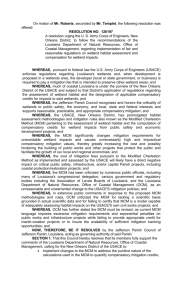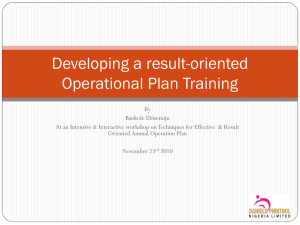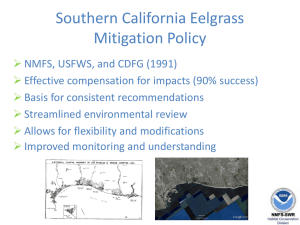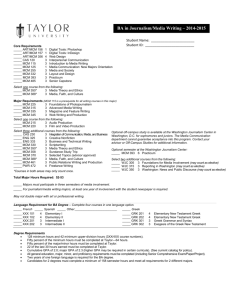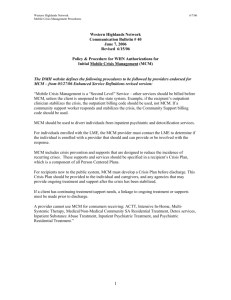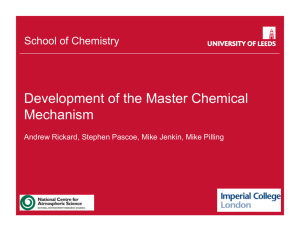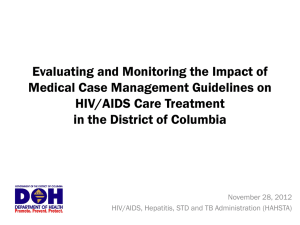Modified Charleston Method - Coastal Protection and Restoration
advertisement
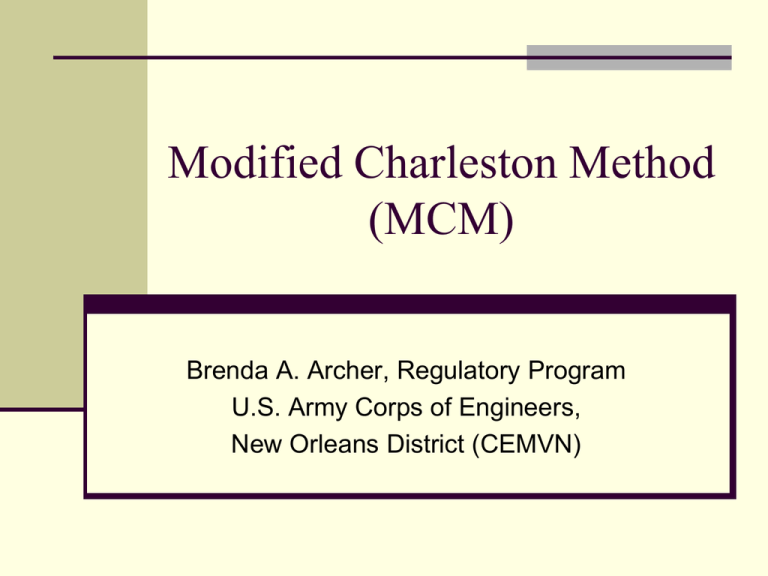
Modified Charleston Method (MCM) Brenda A. Archer, Regulatory Program U.S. Army Corps of Engineers, New Orleans District (CEMVN) What is the MCM? Modified Charleston Method (MCM) An Assessment Methodology for evaluating unavoidable wetland impacts associated with Section 404 Clean Water Act permits and projects that are proposed as mitigation for those unavoidable impacts MCM – Conditional Assessment Model Measures wetland functional loss indirectly by considering the quality of wetland functions of the impacted site weighed against the perceived increases of wetland functions of the mitigation project. Evaluates only the site as it exists at the time of evaluation. History of the MCM Regulatory was tasked with developing an assessment model that: Produced comparable mitigation requirements as other Corps Districts in Louisiana and Promoted consistency among New Orleans District regulatory project managers with diverse backgrounds Interagency Review Team Federal and state resource/regulatory agencies involved in the decisions for the assessment model included: US Environmental Protection Agency US Fish and Wildlife Service National Marine Fisheries Service Louisiana Department of Wildlife and Fisheries Louisiana Department of Natural Resources, Office of Coastal Management Modified Charleston Method The Charleston Method was developed by the Charleston District in collaboration with an Interagency Review Team in that District; Used by Vicksburg District Provides comparable mitigation requirements from the other Districts adjacent to the New Orleans District. After minimal training and practice, project managers are able to easily apply the method with a minimal about of field data collection and a high degree of consistency. Allows unlimited mixing of mitigation locations, and types (e.g. restoration, preservation, enhancement). Allows mixing of mitigation banks and permittee-responsible mitigation projects. Modified Charleston Method (conti-) • Only required slight modifications for it to be used in the New Orleans District. These modifications were to account for • • • Regional wetland differences CEMVN Mitigation Standard Operating Procedures 33 CFR 332: New Mitigation Rule Who can use the MCM? MCM Operators CEMVN permit and mitigation bank project managers for Section 404 CWA permits including restoration and/or enhancement projects Applicants/agents to estimate the amount of mitigation that will be required to compensate for various project scenarios (avoidance and minimization), and to compare mitigation options How does the MCM work? MCM Factors MCM evaluates a suite of factors that are used to assess the potential of the site to perform wetland functions. A factor is an element, circumstance, or influence which contributes to the overall quality of the site. Each factor is defined by a list of options that qualify the factor based on conditions at the evaluated site. The functional value of the site is determined by selecting the options that best fit the site conditions for each factor and then summing all the factor values. MCM Workbook MCM workbook is an excel spreadsheet consisting of four worksheets: “Summary Worksheet”, “Adverse Impact Worksheet”, “Mitigation from Bank Worksheet”, and “Proposed Restoration/Enhancement Mitigation Worksheet”. MCM Guidebook Definitions of terms used in the model Discussions of the use of each worksheet Definitions for each factor and option associated with that worksheet, and Examples using each worksheet. 1. Assessment of Adverse Impacts The model considers; The habitat rarity or difficulty to replace, Site wetland quality, Work involved and the extent to which that work will impact wetland functions, Duration of the impact Potential for project to result in cumulative impacts. Adverse Impacts Worksheet 2. Assessment of Mitigation Project The model considers: Net improvement Negative impacts on the site that can not be remediated, Protection type, Temporal loss, Credit availability versus Credit use. Replacement with in-kind/out-of-kind Location of impact versus mitigation. Restoration Worksheet 3. Kind and Location Factors These factors are included when evaluating an permit project with a particular mitigation bank and/or permittee responsible mitigation project The value for these Factors adjust the required mitigation amount depending upon the degree of variance from the most to least preferred option of in-kind/on-site to out-of-kind/out-of-watershed. Additional Information Resource for MCM Guidebook and Workbook Located in the Regulatory In-Lieu Fee and Bank Information Tracking System (RIBITS) Go to RIBITS from the following website: https://ribits.usace.army.mil Once in RIBITS, Choose “New Orleans District” in the lower, left-hand side of the screen and then the “Assessment Tools” tab in the upper, left-hand side of the screen. Contact Information Dr. James A. Barlow, Section Chief Special Projects and Policy Team (504) 862-2250 or james.a.barlow@usace.army.mil QUESTIONS??
